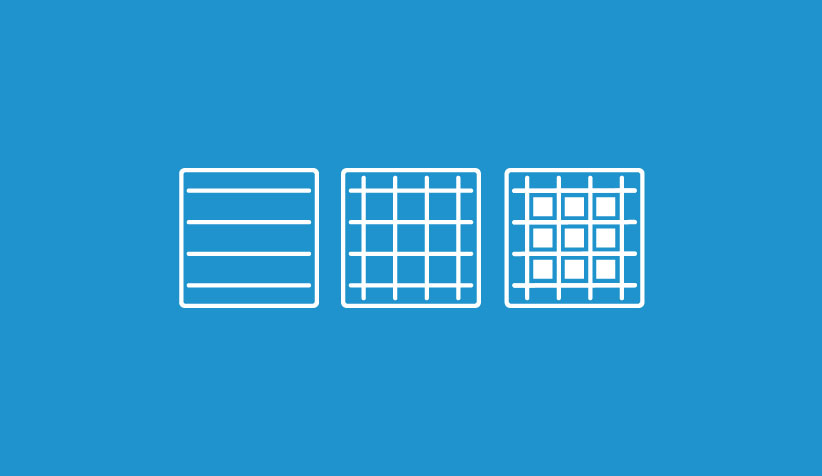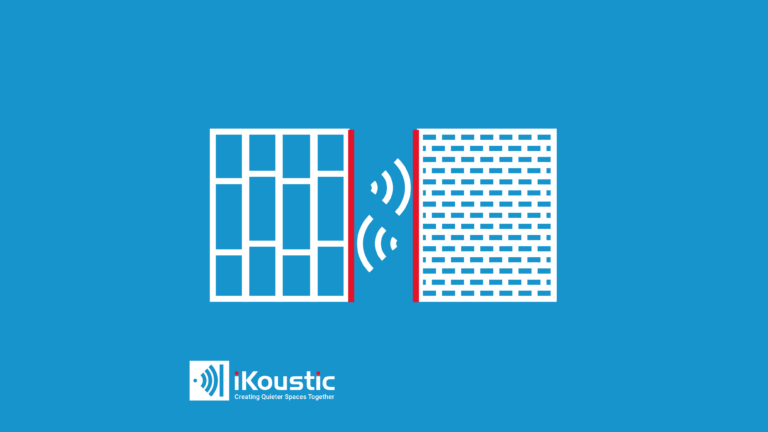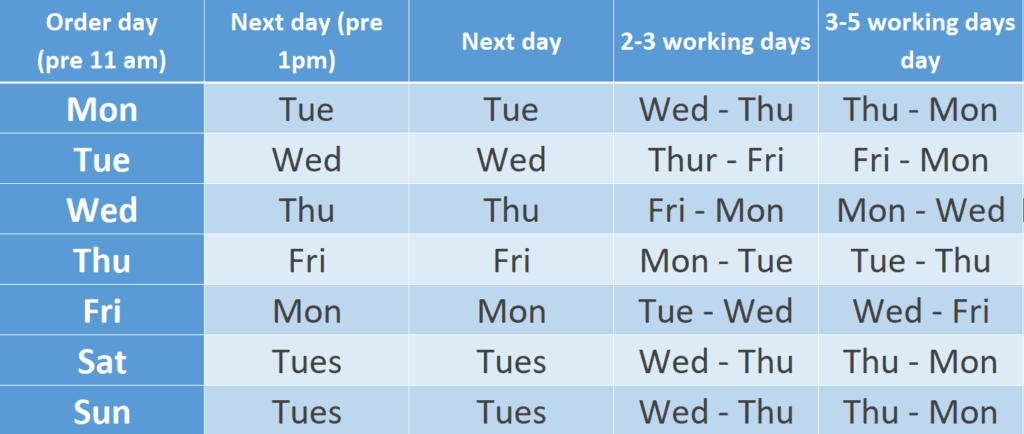How to Soundproof a Wall – Top 3 Solutions
To soundproof a wall, use an isolation clip system with soundproof panels and acoustic insulation. This combination covers the three important elements of soundproofing: decoupling, mass, and absorption.
High-mass materials can reflect noise and insulate your space. Absorption prevents reverberation in cavity spaces, like stud walls, which can make the original noise sound louder. Lastly, decoupling makes a physical separation between materials so sound cannot move from one material to the next with ease.
New to soundproofing? This video will save hours of research!
How to soundproof a wall – step-by-step installation guide
The guide below shows how to soundproof a wall using the best wall soundproofing, the MuteClip and Channel. How do you know which wall soundproofing to use? Don’t worry, we discuss that below!
Soundproofing a brick wall? Although the guide below is for a stud wall the system below still works on brick walls with a few minor tweaks we’ll cover later!
Step 1 – How to soundproof a wall
Install Acoustic Mineral Wool
Sound isolation insulation, like mineral wool, prevents noises from reverberating inside cavity spaces. Reverberation (echo) makes noises appear louder and must be reduced.
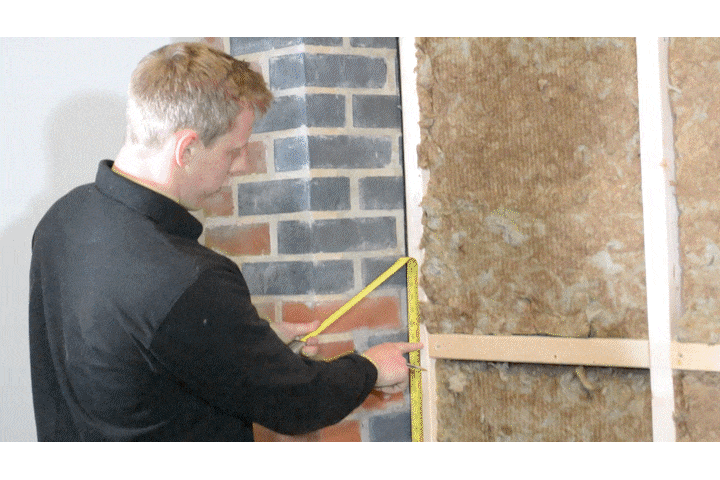
Step 2 – How to soundproof a wall
Measure & Install MuteClips
Use the installation guide to measure and mark out the diamond formation for the MuteClips. These will create a physical separation between the original wall and your new soundproofing panels.
Step 3 – How to soundproof a wall
Clip the Channels into the MuteClips
Squeeze and clip the channels into place. These will support the new layers of acoustic plasterboard and ensure the physical separation. The clip and channel design works like a shock absorber against noise.
Step 4 – How to soundproof a wall
1st Layer of Soundproofing Board
Use self-drilling screws to attach the first layer of soundproofing board. The screws go through the new metal channel so they do not make contact with the wall. a 2-5mm gap is left around the wall’s perimeter.
Step 5 – How to soundproof a wall
Soundproofing Membrane
Adhere a layer of soundproofing membrane to the soundproofing panels. Take time to ensure no air bubbles become trapped and the edges match up.
Step 6 – How to soundproof a wall
The final layer of soundproof board
Screw the last layer of soundproofing board over the membrane. The edges should be staggered differently to layer 1, so that weaknesses cannot form at the edges, Once again, leave a 2-5mm gap.
Step 7 – How to soundproof a wall
Acoustic sealant
Pipe acoustic sealant into he 2-5mm gap all the wall around the wall. This gap prevents vibrations traveling from the adjoining walls, ceiling or floor from traveling into your new partition. This is another decoupling technique!
Step 8 – How to soundproof a wall
Ready for skim plaster and decorating
Our soundproofing systems are ready for skim plaster and decorating straight away. Stick scrim tape over the joins between the acoustic plasterboard before plastering.
Use this one tip to get the right wall soundproofing
Buy it once, get it right.
Which wall soundproofing should you pick? We have a simple piece of advice; go with the best system you have space for! A more expensive system isn’t necessarily going to give a higher performance. Some pricier systems have been designed to fit into small spaces, but can’t perform as well as some thicker, cheaper, options. So figure out how much space you have first, then see which options fit your budget.
Other things to consider include:
- Your wall type, is it brick or stud?
- Where the sound is coming from – check for flanking transmission
- The type of noise – is there a lot of bass or banging?
If your budget constraints your soundproofing, then you are better to wait a little longer and save up the money. It might not be what you want to hear, but it’s honest advice. Wall soundproofing cannot be upgraded as time goes on, because most upgrades require a MuteClip which is the first layer.
How does wall soundproofing work?
Wall soundproofing works on three core concepts. Our best wall soundproofing uses all three to block out noisy neighbours. To soundproof your wall with this technology, the wall should ideally be taken back to brick or stud so that cavities can be filled and clips securely joined to the wall.



Add mass to the wall
Adding mass to the wall will reflect airborne noises (music, TV, talking). This blocks sound from entering or leaving your space so it is insulated against noise.
Reduce vibrations (decouple)
Rigid materials, like plasterboard, brick or timber can conduct sound vibrations, bass noises is a common issue. If they are in direct contact, sound vibrations can travel from one layer to the next more easily. We use materials that can dampen vibrations, like rubber, or better still, create a physical separation with MuteClips. These act as shock absorbers and reduce vibration transmission.
Absorption to reduce the drum effect
When you soundproof your wall you need to include absorption. This will control the drum effect, which is when sound reverberates inside a space and amplifies the noise. Filling wall cavities will reduce this amplification and help to dampen noise.
How to soundproof your wall – The best solution
MuteClip Gold System for Brick and Stud
To soundproof your wall, the first option (and best) is to use the MuteClip isolation system with three layers of soundproofing over it. This can be used on stud walls and brick walls where there are loud airborne noises from noisy neighbours. This is the best defense against bass frequencies, too.
Soundproofing your wall in this way is the best method for noisy neighbours. A layer of soundproofing membrane sits between the acoustic plasterboards and this works like the MuteClips by isolating the rigid materials. You do not need to install this on both sides of the wall.
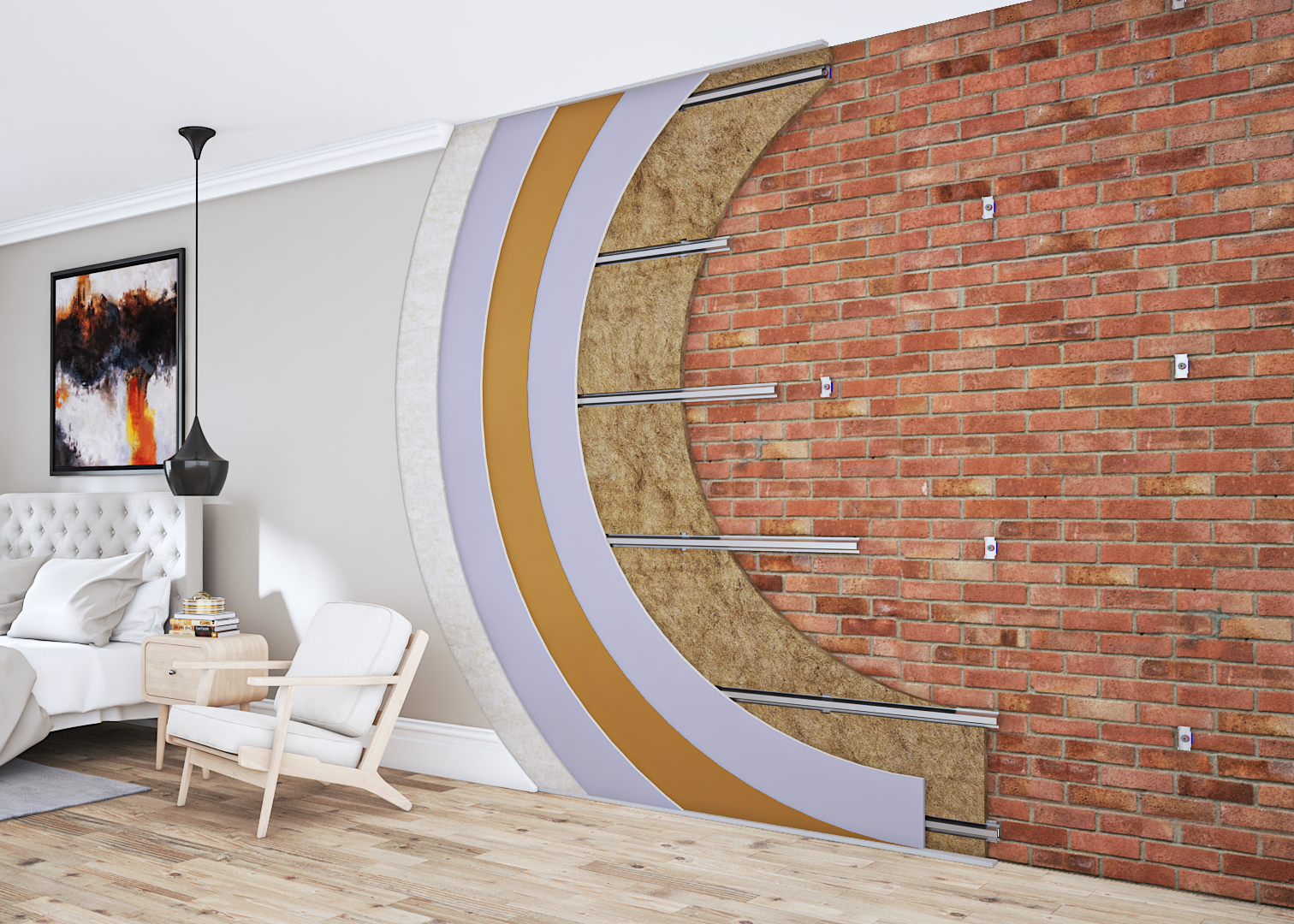
How to soundproof a wall on a budget
MuteClip Bronze System for Brick and Stud Walls
To soundproof a wall on a budget, whilst retaining performance, use the MuteClip system but only one layer of soundproofing board. Using the MuteClip system, even on a budget, is the most efficient use of money. It provides the best wall soundproofing for the space used, and, you would be able to upgrade this system in the future if you wanted.
Soundproofing your room in this way, uses two fewer layers of soundproofing board, but, still uses all three core soundproofing ingredients. This is a better way to soundproof a wall than just soundproofing boards screwed directly to your wall.
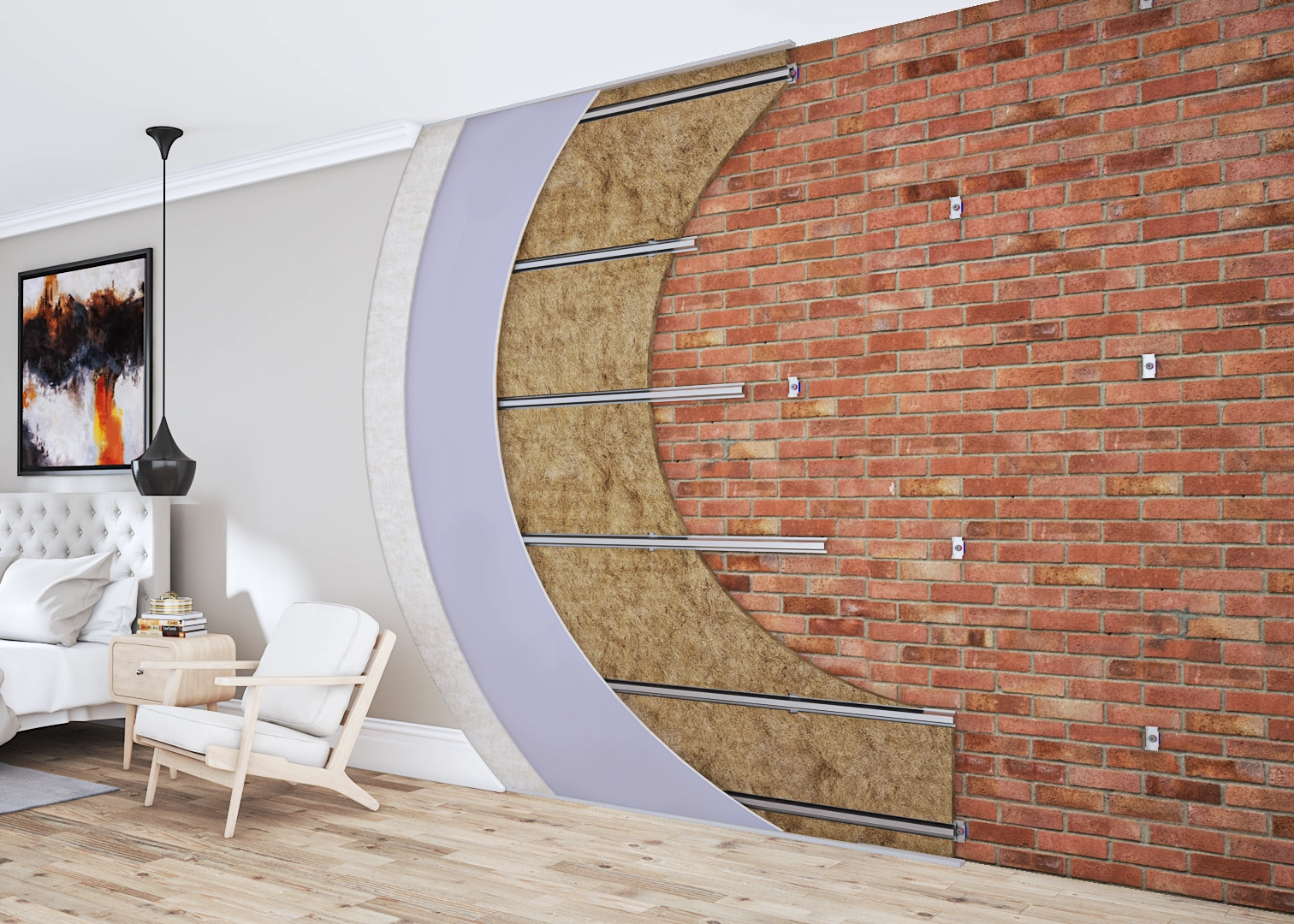
How to soundproof a wall – common mistakes
Don’t make these mistakes!
Wait! Most people do not get the right advice, or understand soundproofing well enough to choose the right system alone. That’s not going to be you, though. We have years of experience in soundproofing and have condensed our best tips into just six points for you.
- Don’t buy a system because it’s cheap, buy it based on the decibel reduction performance.
- Be wary of anyone offering very high dB reductions, no matter how official their data looks.
- Prepare your wall by filling cracks in bricks, rewiring sockets, and exposing the stud work.
- Acoustic mineral wool is not the same as standard insulation and cannot be swapped out.
- A single layer of mass-loaded vinyl/acoustic plasterboard will not soundproof your wall.
- Expandable foam does not soundproof your wall, you need acoustic mineral wool instead.
- Soundproofing paints and wallpapers do not work, don’t use these as a system.
How to soundproof a solid brick party wall
To soundproof a solid brick party wall, (or normal brick wall), you will need a MuteClip system. Using only soundproofing wall panels will not give you a noticeable reduction on most solid brick party walls. This is because the party wall already has a high mass, so you’ll need one of the other two ingredients to block your noisy neighbours out.
The Muteclips will decouple your new soundproofing partition and give you the best soundproofing for the space used. They can be installed directly to the brick, or, with an additional stud frame for extreme cases. You do not to to soundproof both sides of the party wall.
Adding MuteClips and channels to a solid brick party wall also means you can include absorption. Acoustic mineral wool helps to ‘suck’ vibrations out of materials it is in contact with. This means the bricks are less likely to pass vibrations to the panels and your party wall will be better soundproofed.
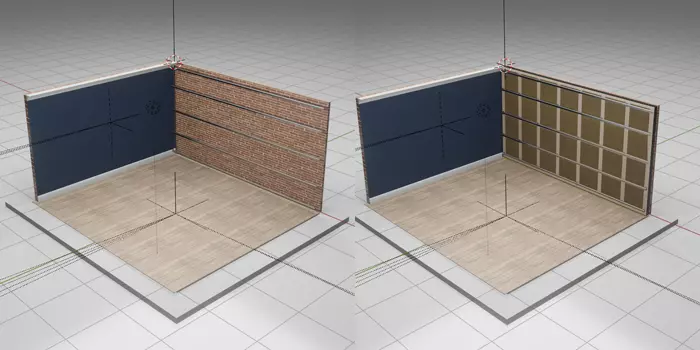
How to soundproof a stud wall
To soundproof a stud wall, you need to add mass with soundproofing panels. Stud walls don’t have much mass to begin with so a lot of sound can get through, making noisy neighbours worse. A direct-to-wall system will have a good effect on stud walls with moderate noise issues.
However, the best stud wall soundproofing is with a MuteClip system. This will greatly improve the performance of your soundproofing. Whichever solution you choose, the original layer of plasterboard must first be removed to fill the cavity with mineral wool.
How to soundproof a wall with flanking transmission
To soundproof a wall with flanking transmission, first identify the type of flanking you have. Common flanking transmission areas include:
- Electric sockets
- Light fixings in ceilings
- Pipework
- Ceiling vibrations into walls
- Floor vibrations into walls
As flanking transmission is caused by sound using alternative pathways to travel over, under or around a partition, we have to treat areas beyond the wall. For problem pipes, you can install an acoustic pipewrap. This dampens sound with a vibration-dampening membrane layer and a layer of mineral wool.
Electric sockets should ideally be rewired to another wall, or, be changed to a wall-mounted box. Both options mean that a large hole is not created in the wall and less sound can get through.
When we install wall soundproofing, we incorporate methods that help decouple, or isolate, the new soundproofing from flanking structures. Flanking structures are other partitions that are in contact with the wall, such as the floor. We use rubber isolation strips and perimeter flanking bands to create vibration-resistant barriers between structures and mitigate the transference of vibrations.
How isolating structures helps soundproof a wall
Isolating structures is one of the three core principles of soundproofing. When it comes to how to soundproof a wall, incorporating isolation technology will give you the best results. We use MuteClips to decouple the surface of soundproofing panels from your original stud or brick walls.
However, we also use isolation strips to decouple stud frames from the surrounding structures. This will help to prevent impact vibrations from people walking or a washing machine running, from travelling up your wall.
How to soundproof a wall – FAQs
To soundproof your wall and avoid mistakes, take a look at the following common issues. Soundproofing is like an art; it needs to be done to the highest standard to ensure a good result. Sound is like water, in that it can leak through even the smallest hole!
So to cover some common troubleshooting questions, see how to soundproof a wall properly with the following tips.
Do I need to soundproof both sides of a wall?
No, you don’t need to soundproof both sides of a wall. Our systems are designed to work with only one side treated. We only suggest treating both sides if Part E building regulations need to be achieved. You will know if this is a regulation you need to meet and it is not relevant to most homeowners.
Can I hang pictures or install my TV onto a soundproof wall?
It is always best to avoid making any holes in a soundproofing wall, as it will compromise the performance. However, we do understand that people need to decorate! Small pin hooks for pictures are not overly intrusive as they will not go through both layers of the soundproofing board. For lightweight frames, try using adhesive hooks.
However, adding screws to the wall for a TV or shelving is not advised. These fixings are much larger and will create holes through both layers of soundproofing board. Instead, use free-standing furniture and enjoy your newfound peace and quiet!
Can I decorate a soundproofed wall straight away?
Yes, a soundproof wall is ready for a skim layer of plaster straight away. Once this has fully dried the wall is ready for wallpaper or painting. The final layer of our soundproofed walls is acoustic plasterboard, so it is easy to decorate.
Can a wall take the new weight of soundproofing?
You should check with a structural engineer before installing soundproofing to ensure the new load can be supported. All soundproofing is heavy, or it wouldn’t work, so the new additional load should be assessed.
Will mass loaded vinyl work on a wall?
By itself, mass loaded vinyl will not provide a big sound reduction on a wall. It will provide almost no difference on a brick wall and a very small reduction on a stud wall. We would not suggest using a single layer of mass loaded vinyl to soundproof your wall. Likewise, a single layer of Tecsound will not soundproof your wall by itself.
We do use mass loaded vinyl, however, it is used alongside other layers of soundproofing. To reflect airborne noise, which is what mass loaded vinyl does, it is best to mix different levels of mass. Different levels of mass reflect different frequencies of sound, so mixing materials gives you protection from children creaming to dogs barking.
Are all brick walls soundproof?
No, brick walls are not soundproof but some are better than others. Thicker brick walls, with more mass, will reflect more airborne noise and could be considered ‘more’ soundproof. However, brick walls can also let a lot of sound into your home.
Brick walls with porous bricks, (lots of small holes), crumbling mortar, and many wall fixings will not provide great soundproofing. Likewise, perforated brick walls have less mass and will not resist as much sound. All brick walls can be improved but some may perform better than others simply because the original wall is more resistant to sound.
How to soundproof a wall with wallpaper
You cannot soundproof a wall with wallpaper. Soundproofing wallpaper is only a few mm thick and has a low mass. Without a high mass, a material cannot reflect noises and soundproof your room. Soundproofing wallpaper sounds too good to be true and I’m afraid it is too good to be true.
How to soundproof a wall with paint
You cannot soundproof a wall with soundproofing paint. Once again, paint does not have a high mass and is unable to insulate a space against noise. Without high mass, a material cannot reflect airborne noises, like music, TV and talking. Likewise, soundproofing wallpaper and curtains are also a myth that will disappoint… and cost quite a lot!

